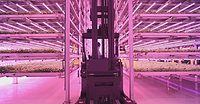New Food Sources and Food Production Systems: Exploring the Food Safety Angle
New food sources can help address security and sustainability challenges, but they may also bring unique food safety issues

Video credit: staticnak1983/Vetta via Getty Images
What is foresight?1 How does it help our agrifood systems and the global food safety arena? The world we live in is constantly evolving. Keeping pace with these changing global contexts—while continuing to deliver safe and nutritious food for the growing global population—rests on the ability of our agrifood systems to sufficiently anticipate, absorb, and adapt to the changes. In this regard, there are concerted efforts underway to transform agrifood systems to make them more resilient, sustainable, and equitable in the face of the economic, environmental, and social challenges of today and those that may arise.
This makes the global agrifood system a very complex space, with all food actors—from food producers, manufacturers, suppliers, and business operators to consumers—functioning within rapidly evolving contexts. This complexity also extends to the food safety landscape, with policies, guidelines, standards, and regulations needing to be kept up to date or further developed to reflect the changing needs within the most current agrifood systems.
Tools like foresight, which comprises structured, forward-looking approaches, allow for the proactive recognition of potential threats, disruptions, opportunities, and challenges that may arise in the medium to long term, bringing varying impacts on the entire global agrifood system. In the food safety context, foresight facilitates the timely identification of drivers and related trends, both within and outside agri-food systems. These drivers and trends have food safety implications and, therefore, also affect consumer health, national economy, and international trade. The determination of such drivers and trends enables better preparedness and helps put into place appropriate strategies and policies to take advantage of future opportunities, as well as manage potential risks.
The Food and Agriculture Organization of the United Nations (FAO) food safety foresight methodology is outlined in a recent publication, "Thinking about the future of food safety—A foresight report."2 The report also describes the major drivers and trends identified through the process, which include climate change,3 new food sources, and food production systems, changing consumer behavior, agriculture within urban spaces, circular economy, microbiome science, new technologies and scientific advances, and food fraud.
New Food Sources
What are new food sources and food production systems? Why are they gaining attention? Growing awareness of the negative impacts of agriculture on the environment and on our finite natural resources, along with the need to find sustainable solutions to feed the rising global population, are propelling efforts to find (or innovate) and bring to the mainstream new food sources and new ways to produce food. The fact that this topic is also receiving increased attention at the level of the Codex Alimentarius underscores the growing importance of this emerging sector.
"New" food sources imply those that have not been widely consumed, either because their consumption has been historically restricted to certain regions of the world or they have recently emerged in the global retail space thanks to technological innovations. New food production systems reflect novel innovations or advancements in pre-existing food technologies that are involved in producing some of the new foods that are finding their way into the mainstream. Some of the new food sources and food production systems explored, by describing both their benefits and challenges, in the recent FAO publication are outlined below.
Edible Insects
Inclusion of edible insects4 in human diets is not new; they have been traditionally consumed in various parts of the world for decades. Farming of edible insects is a fast-expanding sector, driven by proclaimed increased environmental sustainability of the process compared to conventional livestock, fast growth and high fecundity of insects, ease of year-long production, as well as the beneficial nutritional profile of insects. Apart from human food, farmed insects today have a number of different applications, from animal feed to waste management. Some of the commercially important insects for food-based applications are yellow mealworms, crickets, and grasshoppers. Potential food safety risks associated with edible insects are highly dependent on the species of insect, the environment they are reared in or gathered from, what they eat, and the production and processing methods used. As insects tend to be consumed in their entirety, it is important to determine the microbiota of organisms that reside in the insects' guts, as well as on other anatomical parts and surfaces. Several bacterial species are associated with edible insects, and some of these are not only pathogenic and opportunistic bacteria, but they can also be responsible for reducing the shelf life of edible insects. Insects that are reared on agricultural products may be exposed to various agrochemicals (such as pesticides and veterinary drugs) and other chemical hazards (such as mycotoxins and heavy metals), posing a potential food safety risk. According to published literature, individuals allergic to crustaceans may be vulnerable to allergic reactions to edible insects and insect-based food products, particularly mealworms, due to allergen cross-reactivity. A risk is also associated with developing de novo (new) sensitization to yet-unidentified allergens from insects—an area that requires further research.
Jellyfish
While blooms or aggregations of jellyfish are a natural part of the aquatic ecosystem, there is a general agreement that certain regions have observed an increase in some jellyfish blooms over the past few decades. Several factors such as plankton increase, oxygen depletion, overfishing, climate change conditions (e.g., warmer seas, ocean acidification)—among others—can be conducive to these population increases. Large jellyfish blooms are known to cause considerable damage to the fishing and aquaculture industries, as well as to power plants and desalination plants across the world. One of the methods suggested to reduce the numbers of such blooms is to harvest them for consumption, which can seem unconventional; however, jellyfish have long been part of traditional diets in certain parts of Asia.
Regarding food safety concerns, microbial contamination does not seem to be a major issue with jellyfish. Regarding chemical hazards, one of the key concerns is associated with the use of alum (salts of aluminum) for processing, and the subsequent potential high levels of aluminum retained in jellyfish products. Some jellyfish are also known to bioaccumulate heavy metals from the environment, which underscores the importance of monitoring for environmental contaminants in this food source.
Seaweeds
Seaweeds have long been important providers of socioeconomic benefits and contributors to food security around the world through diverse food and non-food applications. Today, global demand for seaweeds is on the rise with farmed seaweeds supplying the greater share. Apart from nutritional properties, seaweeds also provide a number of environmental benefits, such as combating ocean acidification, preventing eutrophication, and providing habitats for fish.
Like with other food sources, seaweeds come with specific potential food safety risks. According to studies, seaweeds can be reservoirs of marine pathogens such as Vibrio parahaemolyticus and Vibrio vulnificus, and this may be a food safety concern since seaweeds can also be consumed raw. In terms of chemical hazards, seaweeds can bioaccumulate heavy metals, such as arsenic and cadmium, from their environments, which can expose consumers to this food safety risk. Certain marine toxin (e.g., ciguatoxin) producing algal species have been reported to be epiphytically associated with certain edible seaweeds. Consumption of seaweeds may also expose consumers to potential high levels of nitrates and iodine content.
Plant-Based Alternatives
The growing trend of adopting diets rich in plant-based foods is propelling advances in the sector of plant-based alternatives to various animal products, such as dairy, meat, eggs, and seafood. Perceived nutritional properties and environmental sustainability of plant-based foods are two major factors influencing the preference of some consumers for this growing sector. However, comparisons based on such criteria between animal-derived products and their plant-based alternatives are not quite straightforward and require closer scrutiny.
Most plant-based alternatives have a high diversity of ingredients that can potentially provide a greater variety of sources from which different food safety hazards may arise. According to published literature, the presence of Fusarium toxins, albeit at low levels, have been found in some plant-based alternatives to dairy products, necessitating the need for monitoring such products for mycotoxins. Other chemical hazards, such as heavy metals and residues of agrochemicals, may be associated with the production of plant-based ingredients used to produce various plant-based alternatives. Another major food safety concern is the allergenic potential of soy, legumes, nuts, and others that find widespread use in such food products.
Cell-Based Food Production
Various new technologies are being explored to produce food, among which is the technology used to produce cell-based food products. In this process, food products that are comparable to animal products are made without the use of large-scale farms, but instead by in vitro cultivation of animal cells. Dozens of companies around the world are involved in developing various cell-based food products. This commercial landscape is fast expanding, with the first cell-based chicken nuggets approved by Singapore authorities in December 2020.
Food safety is one of the foremost considerations when new food production technologies are implemented. While the entirety of cell-based food production can be done in a well-controlled environment, there can be sources of contamination, both biological and chemical, arising at various steps. Animal serum-based culture media, for example fetal bovine serum, are most commonly used at present, and they may present a higher risk for microbiological contamination. Possible food safety concerns may also arise from cryoprotectants that are used for cell storage and unintentionally carried over into final products; the allergenic potential of some scaffolds used in the production process, such as those made from chitin or chitosan; or from residues due to the potential use of antimicrobial agents.
Another area under new food production systems is 3D printing of food, where liquid or semi-liquid food-based materials are used by "printers" to create edible 3D food products. While this technology does not create a "new food," per se, it is definitely a new way of producing some foods with which we are already familiar. With 3D food printers now available for purchase for personal use, it is even more important to determine if food safety issues are present and of concern with this technology. This is especially pertinent considering some of these 3D printers may soon have applications in medical settings, where personalized meals based on specific health requirements are made available to patients. Food safety concerns of 3D printers can arise from the inability to thoroughly clean all the surfaces that come into contact with the food-based material to be printed, providing opportunities for microbial growth and contamination. Moreover, all internal surfaces that come into contact with food must be made from materials that are safe for food use.
The Way Forward for New Foods
While the majority of food safety hazards associated with new food sources and food production systems are not new, the food systems (i.e., the combination of production processes, stakeholders, supply chains, etc.) built for new foods are still relatively new. Therefore, suitable guidelines will need to be established to ensure that food safety is maintained throughout the food chain.
Food safety concerns may also emerge that are unique to the new foods of interest. It is important to recognize and evaluate such food safety issues to help establish appropriate hygiene and manufacturing practices, as well as to develop regulatory frameworks relevant to the sector. Fostering close collaboration and greater engagement among relevant stakeholders will be needed to sustainably integrate these new foods into the existing agrifood systems. After all, "Food safety is everyone's business," as the World Food Safety Day (June 7) motto states.
A challenge for some of these new foods is that of ambiguity in terminology and nomenclature; for example, referring to cell-based meat as conventional "meat" or plant-based alternatives to dairy as "milk." The use of such terminology has implications for relevant existing regulations for food safety and quality assurance, and it can complicate the development of further regulatory instruments and labeling rules.
While not explored in this article, there are other considerations apart from food safety when it comes to barriers to market for new foods. These considerations include consumer perceptions/acceptance, production costs and scale, price of products, lack of appropriate regulatory frameworks to provide oversight, and for some foods, ethical concerns. There is a lack of understanding of the true environmental impacts of new foods. Lifecycle assessments are a commonly used quantitative tool to assess the sustainability of foods and food production systems. However, in the case of new foods, factors such as variability of food production, supply chains, and consumption worldwide, among others, can lead to lack of comparability of lifecycle assessment studies for the same types of products.
Sustainability issues must also be considered when exploiting a new food source. For example, while it may be tempting to harvest jellyfish blooms for consumption, it is important to note that jellyfish populations can be extremely variable in their abundance from year to year. In fact, few jellyfish species are edible, and therefore not all blooms can be managed by fishing them. In addition, only a small subset of jellyfish species form blooms. Focusing on a few species may not be environmentally sustainable as it increases the chances of overfishing them unless proper management strategies are put in place.
To conclude, the changing global contexts of agrifood systems highlight the need for foresight approaches to stay ahead of global challenges and also opportunities. Given the complexity and multidimensionality of food safety and the rapid evolution of scientific advances, application of foresight in the food safety arena will allow food safety actors to identify and prepare for fast-evolving global drivers and trends. This will help underpin and inform the future work of food safety authorities worldwide, as well as help realize the potential of new foods.
Disclaimer
Keya Mukherjee, Ph.D. and Vittorio Fattori, Ph.D.
Food and Agriculture Organization of the United Nations
©FAO, year 2022
Available under CC-BY-NC-SA IGO 3.0
"The views expressed in this publication are those of the author(s) and do not necessarily reflect the views or policies of the Food and Agriculture Organization of the United Nations."
References
- Food and Agriculture Organization of the United Nations (FAO). "Foresight." Food safety and quality. 2022. https://www.fao.org/food-safety/scientific-advice/foresight/en/.
- Food and Agriculture Organization of the United Nations (FAO). "Thinking about the future of food safety—A foresight report." Rome, Italy (2022). https://doi.org/10.4060/cb8667en.
- Food and Agriculture Organization of the United Nations (FAO). "Climate change: Unpacking the burden on food safety." Rome, Italy (2020). https://doi.org/10.4060/ca8185en.
- Food and Agriculture Organization of the United Nations (FAO). "Looking at edible insects from a food safety perspective." Rome, Italy (2021). https://doi.org/10.4060/cb4094en.
Keya Mukherjee, Ph.D., is a Food Safety Specialist at the Food and Agriculture Organization of the United Nations (FAO), within the Food Systems and Food Safety Division.
Vittorio Fattori, Ph.D., is a Food Safety Officer at the Food and Agriculture Organization of the United Nations (FAO), within the Food Systems and Food Safety Division.
Looking for a reprint of this article?
From high-res PDFs to custom plaques, order your copy today!





